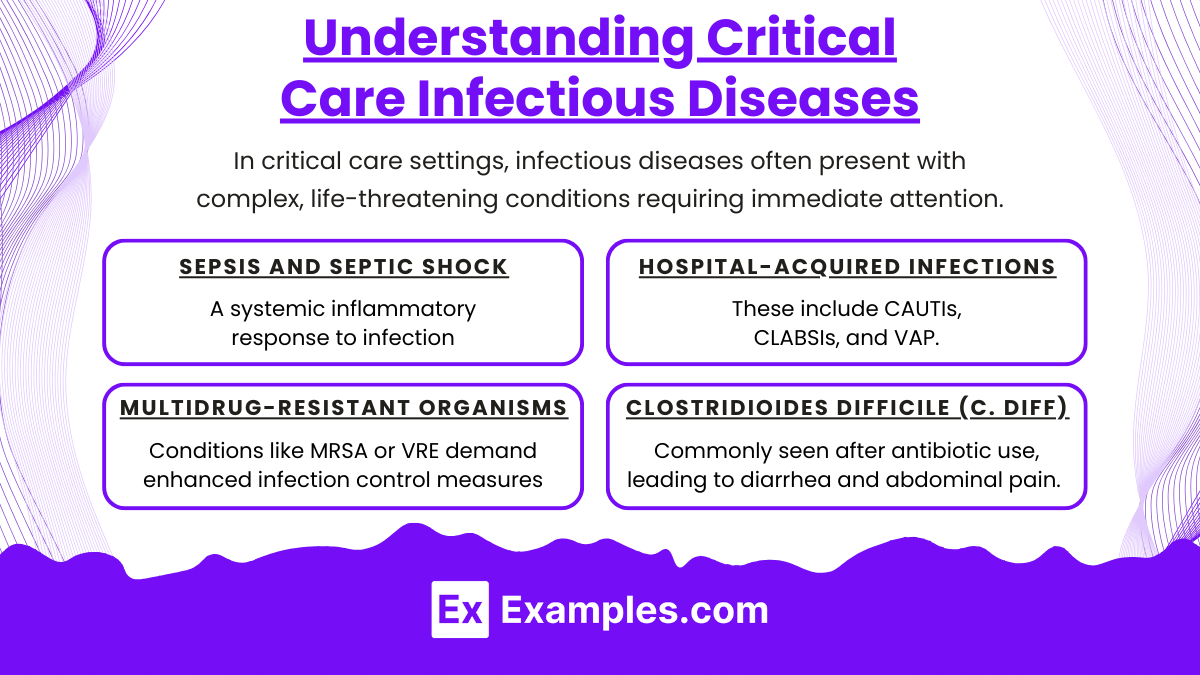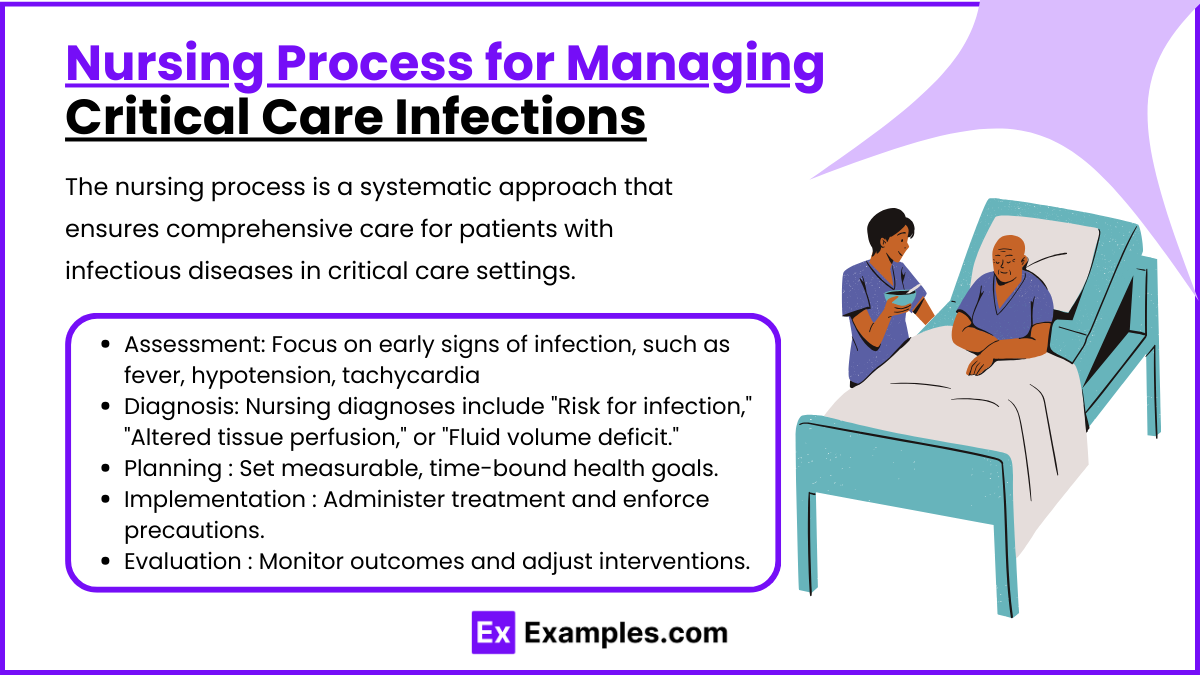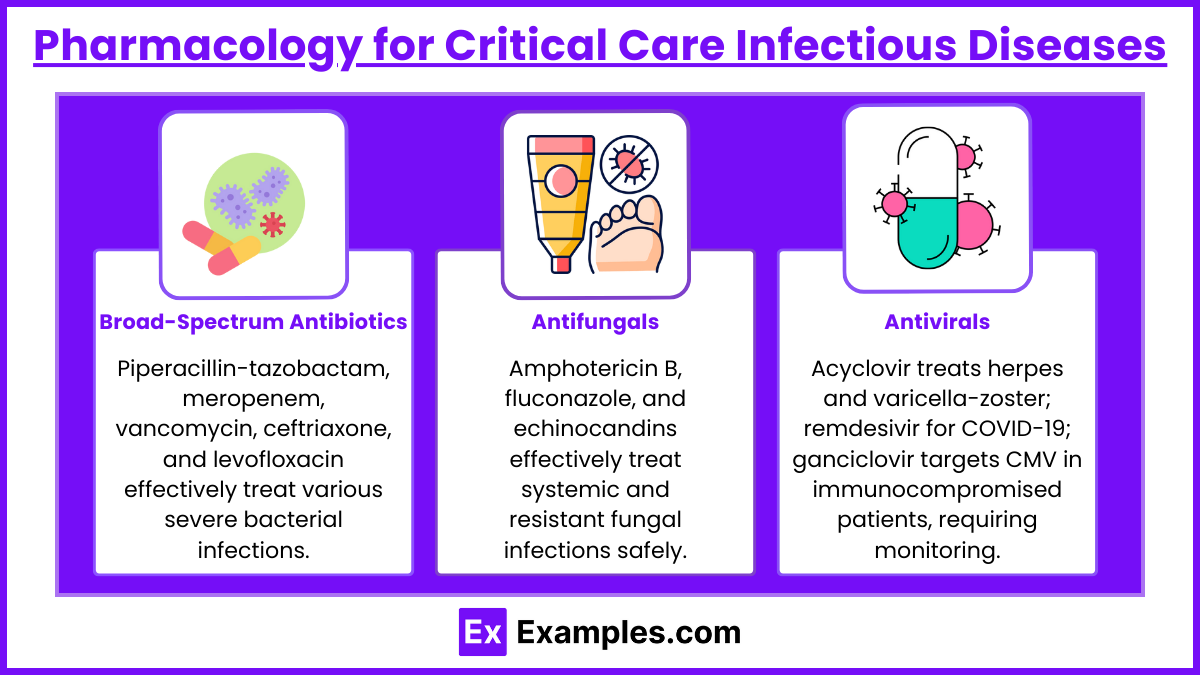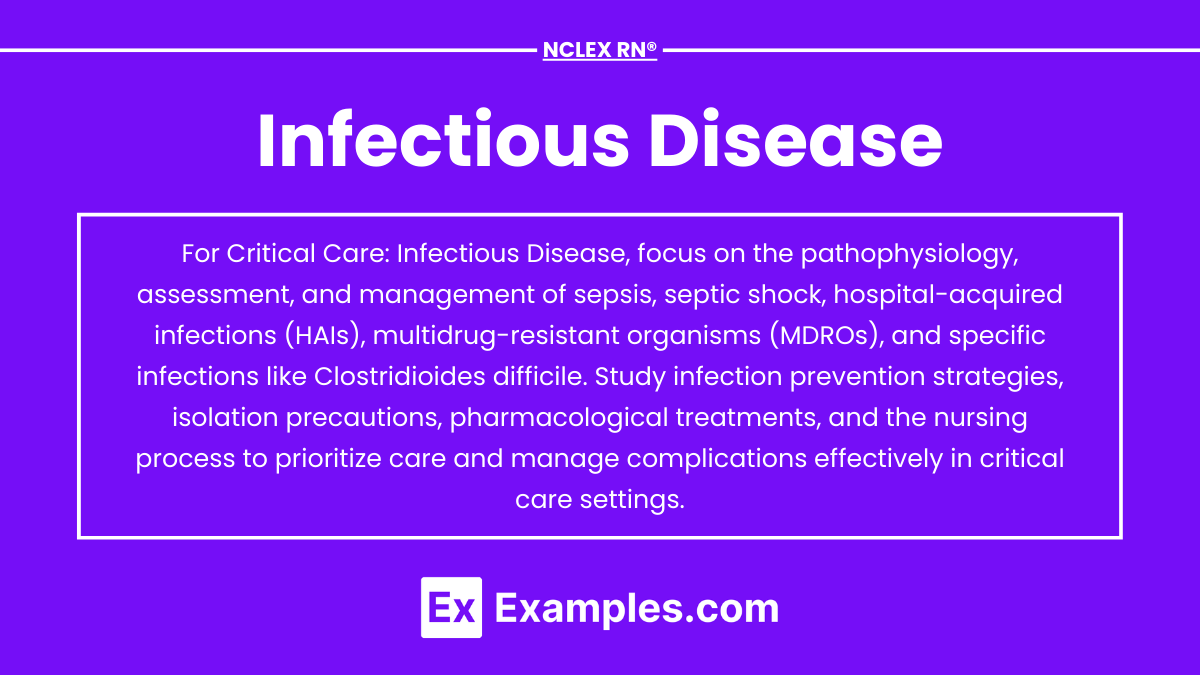Critical care nursing in infectious diseases involves managing life-threatening conditions like sepsis, hospital-acquired infections (HAIs), and multidrug-resistant organisms (MDROs). These conditions require rapid assessment, timely interventions, and strict infection control to prevent complications such as septic shock or organ failure. Nurses must prioritize patient care using evidence-based protocols, including fluid resuscitation, antibiotic therapy, and isolation precautions. Mastering these concepts is essential for excelling on the NCLEX RN®, ensuring safe practice, and delivering effective care to critically ill patients.
Learning Objectives
In studying “Critical Care: Infectious Disease” for the NCLEX RN® Exam, you should learn to recognize and manage life-threatening infectious conditions, including sepsis, septic shock, and hospital-acquired infections. Understand the principles of infection prevention, such as isolation precautions and aseptic techniques, and the pharmacologic management of infections, including antibiotics, antivirals, and antifungals. Analyze clinical presentations, diagnostic tools, and early warning signs to prioritize care and prevent complications. Evaluate nursing interventions for conditions like Clostridioides difficile, multidrug-resistant organisms, and meningitis. Apply your knowledge to interpret patient scenarios, align with the nursing process, and effectively address NCLEX-style critical care questions.
1. Understanding Critical Care Infectious Diseases

In critical care settings, infectious diseases often present with complex, life-threatening conditions requiring immediate attention. These include sepsis, hospital-acquired infections (HAIs), multidrug-resistant organisms (MDROs), and conditions like Clostridioides difficile infection. Early detection is critical to prevent progression to systemic complications such as septic shock or multi-organ failure.
- Sepsis and Septic Shock: A systemic inflammatory response to infection. Early recognition, such as monitoring for tachycardia, hypotension, and altered mental status, is crucial. Treatment includes fluid resuscitation, broad-spectrum antibiotics, and vasopressors if necessary.
- Hospital-Acquired Infections (HAIs): These include CAUTIs, CLABSIs, and VAP. Prevention focuses on strict aseptic techniques, regular line and catheter assessment, and proper PPE use.
- Multidrug-Resistant Organisms (MDROs): Conditions like MRSA or VRE demand enhanced infection control measures, such as contact precautions, and patient-specific antibiotic regimens.
- Clostridioides difficile (C. diff): Commonly seen after antibiotic use, leading to diarrhea and abdominal pain. Key interventions include strict contact precautions and treatment with metronidazole or oral vancomycin.
Understanding these conditions enables nurses to respond proactively and align with NCLEX RN® questions focusing on critical care infectious disease management.
2. Nursing Process for Managing Critical Care Infections

The nursing process is a systematic approach that ensures comprehensive care for patients with infectious diseases in critical care settings. This approach aligns closely with NCLEX RN® expectations, requiring nurses to assess, diagnose, plan, implement, and evaluate interventions effectively.
- Assessment: Focus on early signs of infection, such as fever, hypotension, tachycardia, or localized symptoms like redness and drainage. Utilize lab results like blood cultures, WBC counts, and lactate levels for sepsis detection.
- Diagnosis: Common nursing diagnoses include “Risk for infection,” “Altered tissue perfusion,” or “Fluid volume deficit.” Each diagnosis should guide the plan of care.
- Planning: Set goals to stabilize vital signs, reduce infection spread, and ensure patient education on prevention strategies. Goals should be measurable and time-bound.
- Implementation: Administer prescribed antibiotics promptly, initiate fluid resuscitation in septic patients, maintain strict hand hygiene, and use isolation precautions as needed.
- Evaluation: Reassess patient progress by monitoring vital signs, lab results, and symptom improvement. Evaluate the effectiveness of interventions and adjust plans as necessary.
This structured approach ensures that patients receive timely and effective care, which aligns with safe practice standards tested on the NCLEX RN®.
3. Pharmacology for Critical Care Infectious Diseases

Medications play a significant role in treating critical care infections, and test-takers should be familiar with their indications, side effects, and contraindications.
Broad-Spectrum Antibiotics
Piperacillin-tazobactam, meropenem, vancomycin, ceftriaxone, and levofloxacin effectively treat various severe bacterial infections.
- Piperacillin-Tazobactam (Zosyn): Effective against a wide range of gram-negative and gram-positive organisms, commonly used in sepsis or hospital-acquired infections.
- Meropenem: A carbapenem antibiotic, often reserved for multidrug-resistant infections due to its broad activity.
- Vancomycin: Targets gram-positive infections, especially MRSA. Requires monitoring of trough levels to prevent nephrotoxicity and ototoxicity.
- Ceftriaxone (Rocephin): A third-generation cephalosporin used for severe bacterial infections like meningitis and pneumonia.
- Levofloxacin: A fluoroquinolone effective for respiratory and urinary tract infections but associated with tendon rupture risk.
Antifungals
Amphotericin B, fluconazole, and echinocandins effectively treat systemic and resistant fungal infections safely.
- Amphotericin B: Used for severe systemic fungal infections, such as candidiasis and aspergillosis. Requires monitoring for infusion reactions and renal toxicity.
- Fluconazole: A less toxic alternative for fungal infections like candidiasis, often used in patients with less critical conditions.
- Echinocandins (e.g., Caspofungin): Effective against resistant fungal strains, particularly invasive candidiasis.
Antivirals
Acyclovir treats herpes and varicella-zoster; remdesivir for COVID-19; ganciclovir targets CMV in immunocompromised patients, requiring monitoring.
- Acyclovir (Zovirax): First-line treatment for herpes encephalitis and varicella-zoster virus. Adequate hydration is necessary to prevent nephrotoxicity.
- Remdesivir: Antiviral used in specific cases like COVID-19, with monitoring for hepatotoxicity and hypersensitivity.
- Ganciclovir: Used for cytomegalovirus (CMV) infections, particularly in immunocompromised patients.
Examples
Example 1. Managing a Patient with Sepsis
A patient presents with fever, hypotension, and altered mental status after recent abdominal surgery. The nurse recognizes sepsis and initiates interventions such as obtaining blood cultures, starting broad-spectrum antibiotics, and administering IV fluids. The NCLEX RN® may test on recognizing sepsis criteria, prioritizing care using the Sepsis Bundle, and evaluating the effectiveness of treatment (e.g., normalizing lactate levels).
Example 2. Preventing Ventilator-Associated Pneumonia (VAP)
In a patient receiving mechanical ventilation, the nurse implements evidence-based strategies to prevent VAP, including keeping the head of the bed elevated to 30–45 degrees, performing oral care with chlorhexidine, and suctioning as needed. The NCLEX RN® may focus on interventions for infection prevention in ventilated patients and recognizing early signs of VAP, such as increased secretions or oxygen desaturation.
Example 3. Identifying Clostridioides difficile (C. diff) Infection
A patient on prolonged antibiotic therapy develops profuse watery diarrhea, abdominal pain, and fever. The nurse implements strict contact precautions, avoids antidiarrheal medications, and ensures the patient is treated with oral vancomycin or metronidazole. The NCLEX RN® may include questions on recognizing C. diff symptoms, understanding isolation protocols, and monitoring for complications like dehydration or electrolyte imbalances.
Example 4. Caring for a Patient with Meningitis
A patient arrives with headache, nuchal rigidity, photophobia, and a high fever. The nurse places the patient on droplet precautions, obtains a lumbar puncture for cerebrospinal fluid analysis, and administers antibiotics. The NCLEX RN® may assess knowledge of meningitis symptoms, implementing precautions, and prioritizing interventions to prevent complications like increased intracranial pressure or seizures.
Example 5. Managing Multidrug-Resistant Organisms (MDROs)
A patient with a history of chronic infections is admitted with MRSA in a surgical wound. The nurse implements contact precautions, ensures proper wound care, and administers prescribed antibiotics like vancomycin while monitoring peak and trough levels. The NCLEX RN® may test the nurse’s ability to prevent the spread of MDROs, identify infection risks, and manage complications such as systemic infection.
Practice Questions
Question 1
A nurse is caring for a patient in septic shock. Which intervention is the priority?
A. Administer broad-spectrum antibiotics.
B. Initiate fluid resuscitation.
C. Prepare the patient for intubation.
D. Obtain blood cultures.
Answer: B. Initiate fluid resuscitation.
Explanation: In septic shock, restoring perfusion to vital organs is the immediate priority, which is achieved by initiating fluid resuscitation with isotonic crystalloids like normal saline or lactated Ringer’s. While administering antibiotics and obtaining blood cultures are essential to treating the underlying infection, these interventions come after stabilizing circulation. Intubation is necessary only if respiratory failure occurs, but it is not the first-line intervention.
Question 2
A patient is diagnosed with Clostridioides difficile infection. Which of the following actions should the nurse take?
A. Use alcohol-based hand sanitizer after patient care.
B. Discontinue all antibiotics immediately.
C. Implement strict contact precautions.
D. Administer loperamide to control diarrhea.
Answer: C. Implement strict contact precautions.
Explanation: C. difficile is highly contagious and requires strict contact precautions, including gown and gloves for all interactions. Hand hygiene with soap and water is essential, as alcohol-based hand sanitizers do not eliminate C. difficile spores. Discontinuing antibiotics is considered after consultation with the healthcare provider. Antidiarrheal medications like loperamide should be avoided as they can worsen toxin retention and exacerbate symptoms.
Question 3
The nurse is caring for a patient with a central line. Which intervention is most effective in preventing a central line-associated bloodstream infection (CLABSI)?
A. Change the central line dressing daily.
B. Use sterile gloves when accessing the line.
C. Perform hand hygiene before and after handling the line.
D. Flush the line with heparin daily.
Answer: C. Perform hand hygiene before and after handling the line.
Explanation: Hand hygiene is the single most effective measure in preventing CLABSI. Proper handwashing reduces the risk of contaminating the line or insertion site. While sterile gloves are important, they are secondary to hand hygiene. Changing dressings should follow institutional protocols (usually every 7 days unless soiled), and flushing with heparin is not specifically for infection prevention but to maintain line patency.


